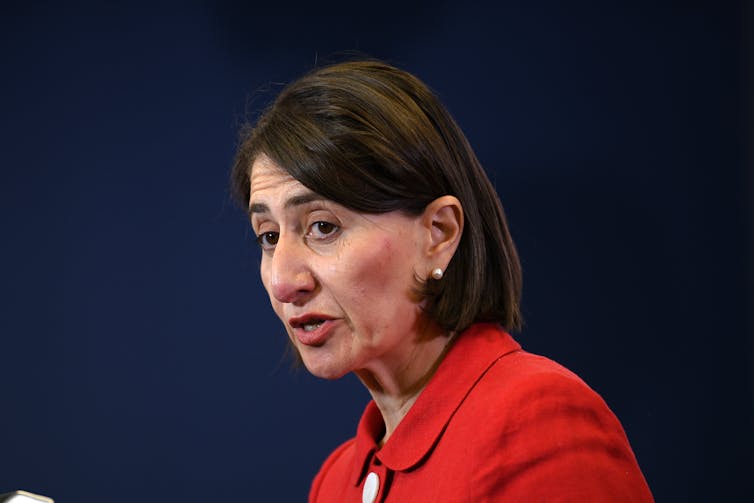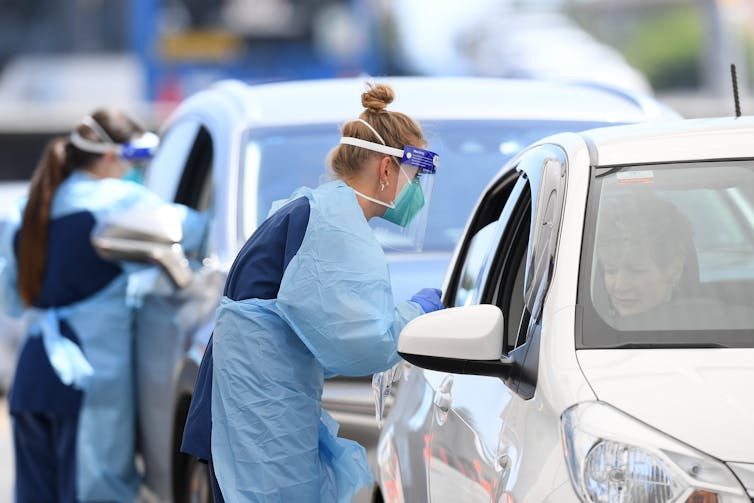The NSW-Vic border will reopen this month, and ironically the risk is greatest for Victoria
- Written by Adrian Esterman, Professor of Biostatistics and Epidemiology, University of South Australia
New South Wales Premier Gladys Berejiklian today announced the border with Victoria will reopen on November 23.
It will be the first time people can freely cross the border since early July.
My preference would be to wait until both states have an extended period of time with zero community transmission of COVID. But I think the risk of a substantial outbreak from opening the border is low.
Victoria has done exceptionally well in squashing its second wave, and has now recorded five consecutive days of zero new cases. Even more pleasingly, the number of mystery cases — those with an unknown source — has dropped to just two in the past fortnight. In saying that, we’ll have to wait another week or so to see the effects of the latest round of eased restrictions.
For the first time in months, it looks as if the COVID situation is worse in NSW than Victoria. Arguably the risk of opening the border is greater for Victoria right now than it is for NSW. Indeed, Berejiklian said today that Victoria “may have, because of the lockdown, actually gone down a path of having eliminated it at this point in time”.
Today NSW recorded nine new cases, six of them among people already in hotel quarantine and three locally acquired. However, those three were already in isolation having previously been identified as close contacts of an existing case.
 NSW Premier Gladys Berejiklian said reopening the border with Victoria was a ‘calculated risk’.
DAN HIMBRECHTS/AAP
NSW Premier Gladys Berejiklian said reopening the border with Victoria was a ‘calculated risk’.
DAN HIMBRECHTS/AAP
Elimination is on the cards
I’m concerned NSW is not going for elimination. It leaves the state as an outlier in Australia, with Victoria now joining all other states and territories by having zero community transmission (although Victoria’s official strategy is “aggressive suppression” rather than outright elimination).
I’d like to see NSW tighten restrictions in a few areas, because I think Australia now has a real shot at eliminating COVID. For example, NSW residents are currently allowed up to 20 visitors at a time, despite the Chief Health Officer recommending no more than ten. As homes are one of the greatest risk areas, why not follow this advice?
In saying that, NSW has shown it’s capable of controlling outbreaks with rapid contact tracing. And Victoria has substantially improved its contact-tracing system over the past few months.
Time for a national approach
Unfortunately, border reopening is likely to make contact tracing more difficult. Many people will cross state borders during summer, particularly over Christmas and New Year.
Contact tracing is currently done on a state-by-state basis, by local teams using their own data sets. It’s not clear whether and how these data will be shared as borders reopen.
For example, if someone is infectious while on a road trip holiday and visits a restaurant in regional Victoria, before driving to towns in NSW and then Queensland, how will contact tracing be organised and shared?
 NSW has shown it’s capable of controlling outbreaks.
DAN HIMBRECHTS/AAP
NSW has shown it’s capable of controlling outbreaks.
DAN HIMBRECHTS/AAP
I’d like to see a coordinated national effort to centralise these data. Ideally, there should be a centralised body, such as an independent federal Centre for Disease Control, which could handle national contract tracing, with regional hubs in each state and territory. This would ensure all states and territories would use the same contact-tracing software, using staff trained to the same level.
A national contact tracing database would then enable the tracking of people travelling interstate. Perhaps a QR code system could be implemented on a national level, so visiting a pub in South Australia means it is recorded in a centralised national database.
A federal disease control agency could also ensure consistency of hotel quarantining, and training of security staff.
Read more: Where did Victoria go so wrong with contact tracing and have they fixed it?
Rapid testing could help
In late September, the Therapeutic Goods Administration approved four rapid antigen tests for COVID.
These tests work by detecting proteins on the outside of the virus, called antigens, from nasal swabs. And they can deliver results in 15 minutes or even quicker.
Yes, their accuracy is not quite as good as the standard COVID tests in that they tend to have a higher rate of false negatives. But I think there’s potential for these to be used as interstate travel increases.
For example, interstate travellers could get one of these tests while waiting for their flights in airports, while crossing land borders by car, or when leaving or arriving by sea.
Read more: The new 15-minute test has potential, but standard tests are still the best way to track COVID-19
Australia has done a fantastic job at controlling COVID, and is the envy of much of the world. Ideally, it would be good to have New South Wales take the extra step to eliminate COVID before borders are completely open, though this might be politically hard. Introducing additional measures like rapid antigen tests, and a hub and spokes contact-tracing system, would go a long way to ameliorating the small risks to other jurisdictions from New South Wales retaining its current suppression approach.
Authors: Adrian Esterman, Professor of Biostatistics and Epidemiology, University of South Australia





